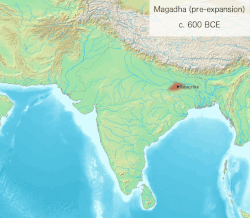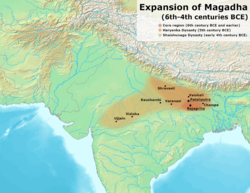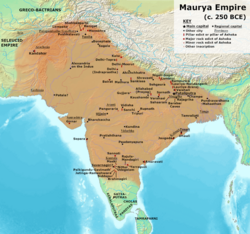Magadha
Magadha | |||||||||||||
|---|---|---|---|---|---|---|---|---|---|---|---|---|---|
| 684 BCE – 28 BCE | |||||||||||||
 Kingdom of Magadha and other Mahajanapadas during the Second Urbanization. | |||||||||||||
Territorial expansion of the Magadha empire 6th century BCE onwards | |||||||||||||
| Capital | Rajagriha (Girivraj) Later, Pataliputra (modern-day Patna) | ||||||||||||
| Common languages | Sanskrit[1] Magadhi Prakrit Ardhamagadhi Prakrit | ||||||||||||
| Religion | Hinduism Buddhism Jainism | ||||||||||||
| Demonym(s) | Māgadhī | ||||||||||||
| Government | Absolute monarchy[a] | ||||||||||||
| Notable Emperors | |||||||||||||
• c. 544 – c. 492 BCE | Bimbisara | ||||||||||||
• c. 492 – c. 460 BCE | Ajatashatru | ||||||||||||
• c. 413 – c. 395 BCE | Shishunaga | ||||||||||||
• c. 395 – c. 367 BCE | Kalashoka | ||||||||||||
• c. 329 – c. 321 BCE | Dhana Nanda | ||||||||||||
• c. 321 – c. 297 BCE | Chandragupta Maurya | ||||||||||||
• c. 268 – c. 232 BCE | Ashoka | ||||||||||||
• c. 185 – c. 149 BCE | Pushyamitra Shunga | ||||||||||||
| Historical era | Iron Age | ||||||||||||
| Currency | Panas | ||||||||||||
| |||||||||||||
| Today part of | India | ||||||||||||
Magadha also called the Kingdom of Magadha or the Magadha Empire, was a
Magadha played an important role in the development of Jainism and Buddhism.[4] It was the core of four of northern India's greatest empires, the Nanda Empire (c. 345 – c. 322 BCE), Maurya Empire (c. 322–185 BCE), Shunga Empire (c. 185–78 BCE) and Gupta Empire (c. 319–550 CE). The Pala Empire also ruled over Magadha and maintained a royal camp in Pataliputra.[5][6]
The Pithipatis of Bodh Gaya referred to themselves as Magadhādipati and ruled in parts of Magadha until the 13th century.[7]
Geography


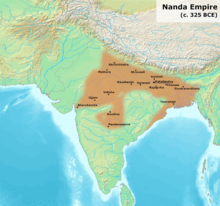


The territory of the Magadha kingdom proper before its expansion was bounded to the north, west, and east respectively by the
The region of
History

Some scholars have identified the
The earliest reference to the Magadha people occurs in the Atharvaveda, where they are found listed along with the Angas, Gandharis and Mujavats. The core of the kingdom was the area of Bihar south of the Ganges; its first capital was Rajagriha (modern day Rajgir), then Pataliputra (modern Patna). Rajagriha was initially known as 'Girivrijja' and later came to be known as so during the reign of Ajatashatru. Magadha expanded to include most of Bihar and Bengal with the conquest of Vajjika League and Anga, respectively.[12] The kingdom of Magadha eventually came to encompass Bihar, Jharkhand, Orissa, West Bengal, eastern Uttar Pradesh, and the areas that are today the nations of Bangladesh and Nepal.[13]
The ancient kingdom of Magadha is heavily mentioned in Jain and Buddhist texts. It is also mentioned in the Ramayana, the Mahabharata and the Puranas.
There is little certain information available on the early rulers of Magadha. The most important sources are the Buddhist
The Hindu Mahabharata calls Brihadratha the first ruler of Magadha. Ripunjaya, last king of Brihadratha dynasty, was killed by his minister Pulika, who established his son Pradyota as the new king. Pradyota dynasty was succeeded by Haryanka dynasty founded by Bimbisara. Bimbisara led an active and expansive policy, conquering the Kingdom of Anga in what is now West Bengal. King Bimbisara was killed by his son, Ajatashatru. Pasenadi, king of neighbouring Kosala and brother-in-law of Bimbisara, promptly reconquered the Kashi province.
Accounts differ slightly as to the cause of
The Haryanka dynasty was overthrown by the
In 326 BCE,
Around 321 BCE, the Nanda Dynasty ended with the defeat of Dhana Nanda at the hands of
During the Pala-period in Magadha from the 11th to 13th century CE, a local Buddhist dynasty known as the Pithipatis of Bodh Gaya ruled as tributaries to Pala Empire.[7]
Buddhism and Jainism
Several Śramaṇic movements had existed before the 6th century BCE, and these influenced both the āstika and nāstika traditions of Indian philosophy.[18] The Śramaṇa movement gave rise to diverse range of heterodox beliefs, ranging from accepting or denying the concept of soul, atomism, antinomian ethics, materialism, atheism, agnosticism, fatalism to free will, idealization of extreme asceticism to that of family life, strict ahimsa (non-violence) and vegetarianism to the permissibility of violence and meat-eating.[19] Magadha kingdom was the nerve centre of this revolution.


According to Indologist
With regard to the Buddha, this area stretched by and large from
The Magadhan religions are termed the
Religious sites in Magadha
Among the Buddhist sites currently found in the Magadha region include two UNESCO
Language
Beginning in the Theravada commentaries, the
Magadhi Prakrit was one of the three dramatic prakrits to emerge following the decline of Sanskrit. It was spoken in Magadha and neighbouring regions and later evolved into modern eastern Indo-Aryan languages like Magahi, Maithili and Bhojpuri.[31]
Dynasties and rulers
The history of Magadha region is very vast, it can be divided into many periods as:
- Vedic Magadha Kingdom :- Kikata Kingdom, Brihadratha dynasty
- Magadha Mahajanapada :- Pradyota dynasty, Haryanka dynasty, Shaishunaga dynasty
- Magadha Empire :- Nanda Empire, Maurya Empire, Shunga Empire, Kanva dynasty
- Classical Magadha :- Gupta Empire, Later Gupta dynasty
- Medieval Magadha :- Pala Empire, Pithipatis of Bodh Gaya
There is much uncertainty about the succession of kings and the precise chronology of Magadha prior to Mahapadma Nanda; the accounts of various ancient texts (all of which were written many centuries later than the era in question) contradict each other on many points.
Two notable rulers of Magadha were
Furthermore, there is a "Long Chronology" and a contrasting "Short Chronology" preferred by some scholars, an issue that is inextricably linked to the uncertain
According to historian K. T. S. Sarao, a proponent of the Short Chronology wherein the Buddha's lifespan was c.477–397 BCE, it can be estimated that Bimbisara was reigning c.457–405 BCE, and Ajatashatru was reigning c.405–373 BCE.[33] According to historian John Keay, a proponent of the "Long Chronology," Bimbisara must have been reigning in the late 5th century BCE,[34] and Ajatashatru in the early 4th century BCE.[35] Keay states that there is great uncertainty about the royal succession after Ajatashatru's death, probably because there was a period of "court intrigues and murders," during which "evidently the throne changed hands frequently, perhaps with more than one incumbent claiming to occupy it at the same time" until Mahapadma Nanda was able to secure the throne.[35]List of rulers
The following "Long Chronology" is according to the Buddhist
- Haryanka dynasty (c. 544 – 413 BCE)
| Ruler | Reign (BCE) |
|---|---|
| Bimbisara | 544–491 BCE |
| Ajatashatru | 491–461 BCE |
| Udayin | 461–428 BCE |
| Anirudha | 428–419 BCE |
| Munda | 419–417 BCE |
| Darshaka | 417–415 BCE |
| Nāgadāsaka | 415–413 BCE |
- Shishunaga dynasty(c. 413 – 345 BCE)
| Ruler | Reign (BCE) |
|---|---|
| Shishunaga | 413–395 BCE |
| Kalashoka | 395–377 BCE |
| Kshemadharman | 377–365 BCE |
| Kshatraujas | 365–355 BCE |
Nandivardhana |
355–349 BCE |
| Mahanandin | 349–345 BCE |
- Nanda Empire (c. 345 – c. 322 BCE)
| Ruler | Reign (BCE) |
|---|---|
| Mahapadma Nanda | 345–340 BCE |
| Pandhukananda | 340–339 BCE |
| Panghupatinanda | 339–338 BCE |
| Bhutapalananda | 338–337 BCE |
| Rashtrapalananada | 337–336 BCE |
| Govishanakananda | 336–335 BCE |
| Dashasidkhakananda | 335–334 BCE |
| Kaivartananda | 334–333 BCE |
| Karvinathanand | 333–330 BCE |
| Dhana Nanda | 330–322 BCE |
Other lists
The
- Shishunaga dynasty (360 years)
- Shishunaga (reigned for 40 years)
- Kakavarna (36 years)
- Kshemadharman (20 years)
- Kshatraujas (29 years)
- Bimbisara (28 years)
- Ajatashatru (25 years)
- Darbhaka or Darshaka or Harshaka (25 years)
- Udayin (33 years)
- Nandivardhana (42 years)
- Mahanandin (43 years)
- Nanda dynasty (100 years)
- List by Jain literature
A shorter list appears in the Jain tradition, which simply lists Shrenika (Bimbisara), Kunika (Ajatashatru), Udayin, followed by the Nanda dynasty.[37]
Historical figures from Magadha
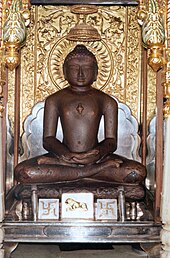
Important people from the ancient region of Magadha include:
- Maudgalyāyana.[38]
- Maudgalyāyana – born in the village of Kolita in Magadha. He was one of the Buddha's two main disciples. In his youth, he was a spiritual wanderer before meeting the Buddha.[39]
- Mahavira – the 24th Tirthankara of Jainism. Born into a royal kshatriya family in what is now Vaishali district of Bihar. He abandoned all worldly possessions at the age of 30 and became an ascetic. He is considered a slightly older contemporary of the Buddha.[40]
- Mahāmudrā transmission. Born in the village of Jhatakarani in Magadha. Also associated with the monasteries of Nalanda and Vikramashila.[41]
See also
- Mahajanapadas
- History of India
- Magadha-Vajji war
- Magadha-Anga war
- Avanti-Magadhan Wars
- List of Indian monarchs
- Timeline of Indian history
- Magahi Culture
- Magahi Languages
Notes
- ^ as described in the Arthashastra
References
- ISBN 978-1-135-79711-9.
- JSTOR 41784405.
- JSTOR 44141530.
- ISBN 978-0-19-157917-2.
- ISBN 978-81-7017-301-4.
- ^ Jha, Tushar; Tyagi, Satish (2017). "CONTOURS OF THE POLITICAL LEGITIMATION STRATEGY OF THE RULERS OF PALA DYNASTY IN BENGAL- BIHAR (CE 730 TO CE 1165)". Proceedings of the Indian History Congress. 78: 49–58.
- ^ ISBN 9780861592289.
- ^ Raychaudhuri, Hemchandra (1953). Political History of Ancient India: From the Accession of Parikshit to the Extinction of Gupta Dynasty. University of Calcutta. pp. 110–118.
- ^ a b c Bronkhorst 2007, p. [page needed].
- ISBN 9788120813328.
- ^ M. Witzel. "Rigvedic history: poets, chieftains, and polities," in The Indo-Aryans of Ancient South Asia: Language, Material Culture and Ethnicity. ed. G. Erdosy (Walter de Gruyer, 1995), p. 333
- ISBN 81-208-0436-8.
- ^ Sinha, Bindeshwari Prasad (1977). Dynastic History of Magadha, Cir. 450–1200 A.D. Abhinav Publications. p. 128.
- JSTOR 44145194.
- ^ "Lumbini Development Trust: Restoring the Lumbini Garden". Archived from the original on 6 March 2014. Retrieved 6 January 2017.
- ^ Tenzin Tharpa, Tibetan Buddhist Essentials: A Study Guide for the 21st Century: Volume 1: Introduction, Origin, and Adaptation, p.31
- ^ Sanjeev Sanyal (2016), The Ocean of Churn: How the Indian Ocean Shaped Human History, section "Ashoka, the not so great"
- ISBN 978-0195134834.
- ISBN 978-8120817760.
- ISBN 978-1-60693-846-1.
- OCLC 608555139.
- S2CID 144673508.
- ^ Bronkhorst 2007, pp. xi, 4.
- ^ a b Bronkhorst 2007, p. 265.
- ^ Wynne, Alexander (2011). "Review of Bronkhorst, Johannes, Greater Magadha: Studies in the Culture of Early India". H-Buddhism. Retrieved 25 August 2019.
- ISBN 9789811580673.
- ISBN 978-1-4985-5493-0.
- ISBN 978-0-415-68452-1.
- ^ A Dictionary of the Pali Language By Robert Cæsar Childers
- ISBN 978-0-19-283925-1.
- ISBN 978-1-139-20887-1.
- ISBN 978-81-7030-469-2.
- S2CID 141897826
- ISBN 978-0-8021-9550-0.
- ^ ISBN 978-0-8021-9550-0.
- ISBN 978-81-7030-469-2.
- ^ a b Geiger, Wilhelm; Bode, Mabel Haynes (25 August 1912). "Mahavamsa : the great chronicle of Ceylon". London : Pub. for the Pali Text Society by Oxford Univ. Pr. – via Internet Archive.
- JSTOR 29756860.
- ISBN 978-81-208-3022-6.
- ISBN 978-1-136-38189-8.
- JSTOR 603308.
Sources
- Raychaudhuri, H.C. (1972). Political History of Ancient India. Calcutta: University of Calcutta.
- Law, Bimala Churn (1926). "4. The Magadhas". Ancient Indian Tribes. Lahore: Motilal Banarsidas.
- Bronkhorst, Johannes (2007). Greater Magadha: studies in the culture of early India (PDF). Handbook of oriental studies. Section two, India. Vol. 19. Leiden; Boston: Brill. OCLC 608455986. Archived from the original(PDF) on 11 September 2015.
- ISBN 978-81-317-1677-9

